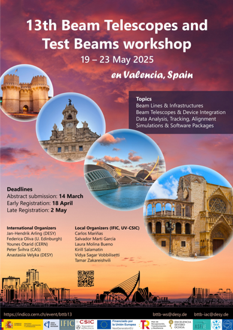Speaker
Description
The experimental results at CERN's LHC confirmed the Standard Model with high precision. However, several questions are still open and successors for the High-Luminosity LHCs are proposed to explore the Standard Model with unprecedented precision. Future colliders, like the FCC-ee and Muon Collider, aim to measure Higgs Yukawa couplings and self-interactions with unprecedented accuracy, requiring precise jet energy measurements and advanced calorimetry with Particle Flow algorithms.
This contribution presents the studies for the development of a hadronic calorimeter using resistive Micro Pattern Gaseous Detectors (MPGD). This MPGD-based calorimeter is ideal for PFA, thanks to the high-granular readout capabilities (O(cm2)), and particularly suitable for the Muon Collider background conditions, thanks to its radiation-hard technology and high rate capabilities (up to 10 MHz/cm2). Furthermore, resistive MPGDs, such as resistive Micromegas and µ-RWELL, offer excellent spatial resolution, operational stability (discharge quenching), and uniformity, making them well-suited for calorimetry.
This work presents the results on efficiency, response uniformity, as well as spatial and temporal resolution, obtained using a muon beam at CERN SPS for three MPGD technologies: resistive MicroMegas, µ-RWELL, and RPWELL. Additionally, it includes findings from tests on an hadronic calorimeter cell prototype, composed of eight alternating layers (~1 λ$_{I}$) of stainless steel and MPGD detectors, using pion beams with energies up to 10 GeV.
